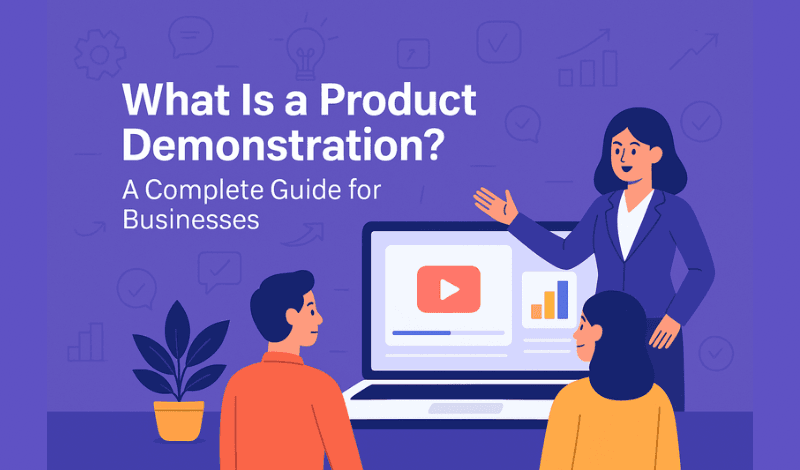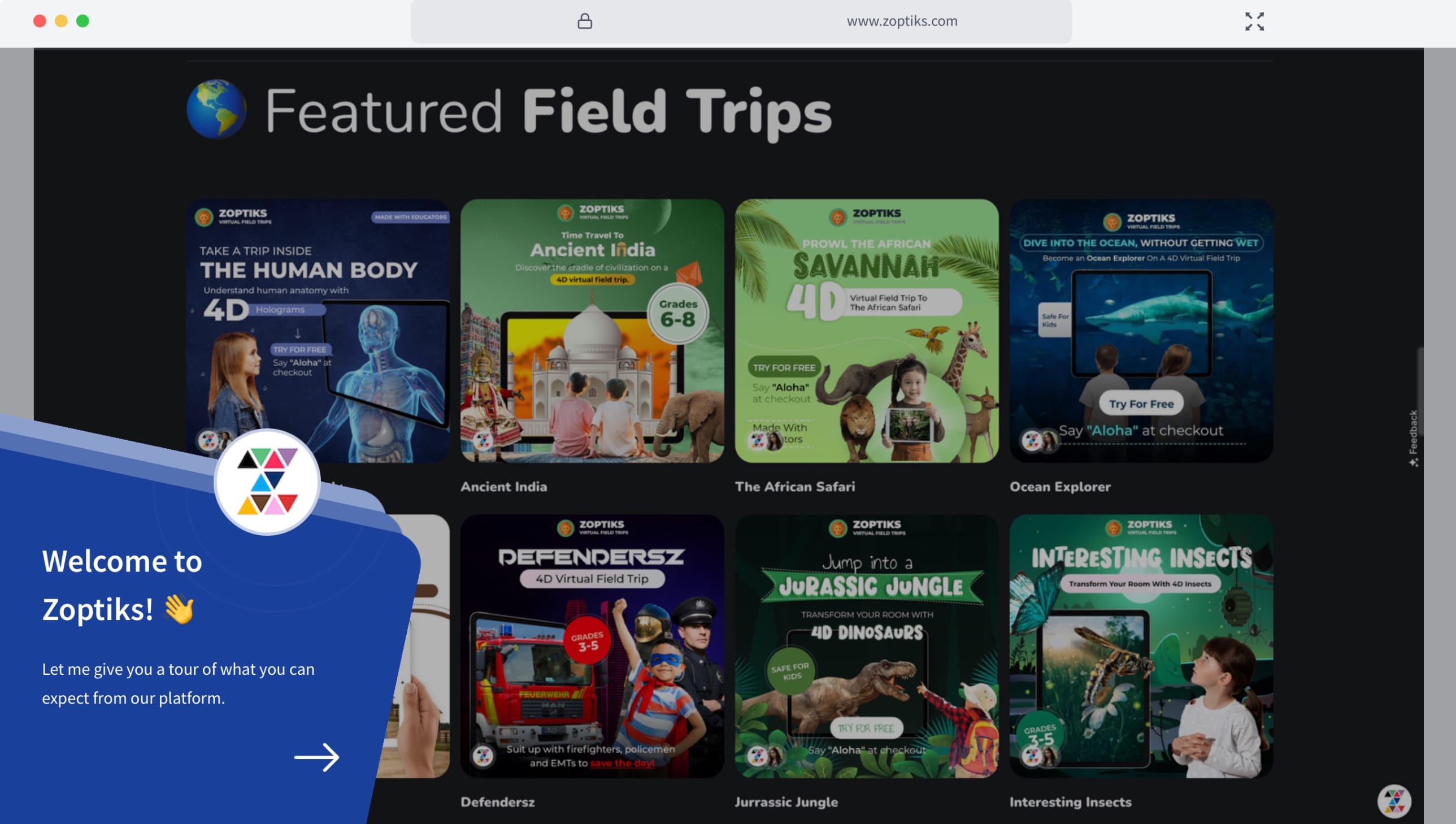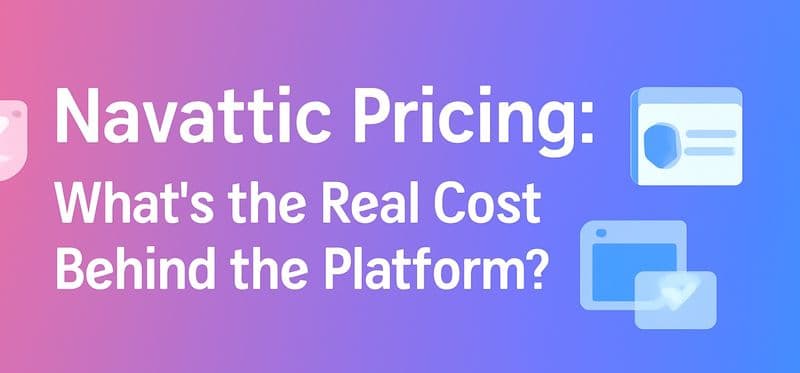
TL;DR
|
Ever sat through a demo where the presenter spent 20 minutes talking about features you didn’t care about, only for you to leave more confused than when you joined? The truth is, bad product demonstrations are everywhere. They either drown you in jargon, feel like a scripted infomercial, or rush past the very problem you needed solved.
For prospects, that means lost interest. For businesses, that means lost revenue. Nobody wins when a demo feels like a lecture you can’t sneak out of. But here’s the good news: a product demonstration doesn’t have to be boring or confusing.
In this blog, we’ll walk you through what is product demos, why it matters, the different types you can use, and the best practices to make sure your next demo has prospects saying, “Where do I sign?” instead of “Where’s the exit?”
What Is a Product Demonstration?
Think of a product demonstration as a test drive for your software. Instead of just hearing about a car’s horsepower, you get behind the wheel, feel the steering, and know if it really meets your expectation. In the same way, a demo shows prospective customers how the product works in real time, not just what buttons exist, but how it actually fixes their pain points.
For most SaaS companies, a demo happens in the consideration stage of the sales funnel. A sales rep or account executive might run a live demo, share a product demo video, or guide someone through an interactive demo. The point isn’t to show every single feature, but to highlight the product’s value proposition in a way that makes the target audience say: “Yes, this is exactly what I need. What’s the next step?”
Why Are Product Demonstrations Important?
I still remember sitting through a demo where the rep spent 15 minutes explaining dropdown menus. Not once did they show how the tool could actually make my job easier. By the end, I wasn’t just bored, I was unconvinced.
That’s why product demonstrations are such a critical step in the sales cycle; they shape how prospects see your product and whether they believe it’s worth their time. Here’s how they do that:
1. Building Trust With Prospects: When sales reps demonstrate in real time how a product works, it instantly adds credibility. It shows confidence in the product and reassures prospective customers that it can solve their pain points.
2. Making Use Cases Real: The most effective product demo doesn’t stop at highlighting best features. It ties those features to a real use case, so the target audience sees exactly how the product’s value proposition applies to their specific needs.
3. Reducing Hesitation, Boosting Conversions: Every sales cycle comes with doubts. A well-delivered demo addresses objections head-on, reduces purchase hesitation, and gives prospective customers the clarity they need to move to the next step in the sales process. That’s where conversion rates start to climb.
4. Setting Up Long-Term Success: A successful product demonstration also lays the groundwork for customer experience. Especially in SaaS demos, showing value early means new users enter onboarding already familiar with the product’s value, making retention far easier.
What Are the Different Types of Product Demonstrations?

Not every demo works the same way. I’ve sat in live demos that felt like stage plays, watched demo videos that explained a product better than the rep could, and clicked through interactive demos that let me explore at my own pace. Each format has its place; it just depends on the audience and the sales strategy.
1. Live Product Demonstration
Delivered either in person or over a video call, a live demo gives prospective customers the chance to see the product in action with a sales rep guiding them. The upside is real-time interaction, and that means questions can be answered on the spot. The downside? Scheduling challenges and the risk of losing attention if the flow drags.
2. Recorded Product Demo Video
A pre-recorded walkthrough is perfect for scale. One good product demo video can be shared endlessly in the sales funnel, used for marketing, or embedded in a knowledge base. The limitation is that it’s one-size-fits-all; great for awareness, less effective for handling specific pain points.
3. Interactive Product Demonstration
This is the hands-on option. Prospective customers click through a guided product tour, seeing different features at their own pace. Interactive product demos are a compelling way to boost engagement because they put control in the buyer’s hands.
4. Custom or Tailored Demo
When you’re dealing with enterprise customers or high-value deals, nothing beats personalization. A tailored demo zeroes in on the product’s value proposition for specific needs, showing the target audience how the product fits their sales process or use case. The trade-off is time; building a personalized demo takes effort, but it often pays off in close rates.
Product Demo vs Sales Demo: Are They the Same?
These two terms are often thrown around like they mean the same thing. And to be fair, even sales teams mix them up. But there is a difference, and knowing it helps you decide which approach works best for your prospective customers.
Aspect | Product Demo | Sales Demo |
|---|---|---|
Purpose | Show how the product works and highlight key features | Persuade prospective customers to make a purchase decision |
Focus | Product’s features, functionality, and use cases | Product’s value, ROI, and how it solves specific pain points |
Delivery | Often done by sales reps or product specialists | Usually led by account executives in the sales process |
Audience | Qualified leads or new users evaluating a solution | Prospective customers deeper in the sales cycle, ready for a sales pitch |
Format | Live demo, demo video, product tour, or interactive demo | Tailored conversation with a clear call to action |
Outcome | Educates target audience, helps them explore product experience | Moves buyers toward the next step, and that’s often to close deals |
In practice, the line between them is thin; a successful product demonstration usually borrows from a sales demo, weaving in both the product’s value proposition and the push toward a next step in the sales cycle.
What Are the Top Tips for Running an Effective Product Demonstration?
We’ve seen demos flop because they tried to do everything at once, and I’ve seen others win deals by keeping things simple and relevant. Over time, I’ve learned there are a few non-negotiables that make the difference between a forgettable walkthrough and a successful product demonstration. Here’s what I keep in mind every time I run one.
1. Keep It Short and Focused: No one came to watch a feature documentary. A great demo respects attention spans by spotlighting only the key features that matter to the target audience.
2. Personalize for the Audience: A one-size-fits-all demo is an easy task, but it never lands. When you tailor the flow to a prospect’s specific pain points, the product experience feels instantly more relevant.
3. Highlight the Value Proposition: Features are fine, but what matters is the product’s value. Always connect what you are showing back to the product’s value proposition, so prospects understand the “why,” not just the “what.”
4. Use Storytelling to Connect: Even complex products become easier to follow when framed through a story or relatable use case. Instead of saying “here’s a dashboard,” show how that dashboard solves a real problem in the sales process.
5. Include Social Proof: People trust people. Dropping in quick testimonials or case studies during a demo reassures prospective customers that others have already benefited from the product.
6. End With a Clear Next Step: The worst demos trail off with “so… any questions?”. Always wrap with a clear CTA, whether that’s a free trial, a personalized demo, or a follow-up sales pitch.
Why Choose SmartCue for Your Interactive Product Demonstration?
One of the biggest reasons deals stall is timing. Prospects are interested, but scheduling a live demo doesn’t always happen. By the time calendars align, momentum is gone and opportunities slip away.
SmartCue solves this by making demos accessible anytime. Instead of waiting for a call, sales teams can share interactive, self-serve demos that prospects explore on their own schedule. Each walkthrough feels personalized, highlights the product’s value in context, and keeps buyers moving through the sales funnel.
What sets SmartCue apart?
Speed: Create and update demos in just minutes.
Scalability: Build entire demo libraries tailored to different use cases.
Easy sharing: Send demos directly to prospects across email, landing pages, or chat.
Analytics: Track which features resonate most to follow up with relevance and close deals faster.
SmartCue turns product demonstrations from a scheduling headache into a scalable sales tool, one that keeps engagement high and conversations moving.
Ready to see the difference for yourself? Try SmartCue free for 14 days and start creating interactive product demos that engage prospects and keep deals moving.
How to Create a Product Demo Video with SmartCue?
Creating a product demonstration video doesn’t have to be a marathon project. With SmartCue, you can build an interactive, engaging demo in minutes: no production crew, no editing headaches, no wasted time. Here’s how to demo a software product:
Step 1: Sign Up and Install the Extension

Start with SmartCue’s free trial and set up your workspace. Once the Chrome extension is installed, you’re ready to capture your product in action; it’s as simple as hitting record.
Step 2: Capture the Flow That Matters

Record a walkthrough from scratch or start with a template. SmartCue makes it easy to spotlight specific flows and highlight the key features prospects care about, instead of overwhelming them with everything at once.
Step 3: Add Context and Interactivity

Raw recordings can be messy. That’s why SmartCue lets you add tooltips, text overlays, and guided steps to turn a simple screen capture into a clear product tour. Prospects don’t just watch, but they understand.
Step 4: Share and Learn From Engagement

Once your demo is polished, share it as a link, embed it on your site, or drop it into an email. The best part? You get analytics on how prospects engage, like what they click, where they drop off, and which features catch their eye. That insight turns every demo into a smarter sales pitch.
How These SaaS Brands Nailed Their Product Demonstrations With SmartCue: Real Examples
Most demos feel like a scripted lecture, someone clicking through menus while the audience zones out. But a few SaaS brands are showing that a product demonstration doesn’t have to be boring. With SmartCue, they turned their demos into interactive experiences that sell outcomes, not just features.
Here’s how three companies pulled off their product demo software:
1. NexLvL – Making CRM Automation Feel Effortless

What they do: AI-powered CRM with automation and chat integrations
NexLvL didn’t want another long-winded sales demo. Instead, they built a guided SmartCue product tour that lets users click through tasks and workflows themselves. Prospects see how automation reduces manual work and how integrations fit directly into their sales process.
Why it works:
Hands control to the user, creating a personalized demo experience
Shows value through outcomes, not feature overload
Helps prospects visualize how the tool solves their pain points
2. Guardey – Making Cybersecurity Approachable

What they do: Accessible cybersecurity and awareness training
Cybersecurity is usually complex and intimidating, but Guardey flips the script. Their SmartCue demo walks prospects through real-world threat detection and protection scenarios in plain language. Instead of technical jargon, users see exactly how Guardey works in real time.
Why it works:
Breaks down a complex product into an easy-to-grasp flow
Builds trust by showing real-time value
Makes cybersecurity accessible to a wider target audience
3. Zoptiks – Turning Learning Into Exploration

What they do: Virtual field trips and microschool learning platform
Zoptiks uses SmartCue to take education beyond static slides. Their demo invites teachers and students to explore virtual environments hands-on, showing how lessons become immersive and memorable. It’s not just a walkthrough, but it’s an experience.
Why it works:
Uses storytelling to connect emotionally with prospective customers
Focuses on outcomes like engagement and retention, not just features
Delivers a compelling way to show product value in action
These brands prove that a good demo doesn’t just explain what a product does, but it creates a product experience that drives real results.
Turning Demos Into Decisions
A product demonstration isn’t just another sales step, it’s the moment curiosity turns into conviction. Buyers don’t want to be pitched; they want to see how a product solves their pain points.
The best demos hand control to the prospect. Whether it’s an interactive demo, a tailored product tour, or a self-serve video demonstration, the goal is the same: show value, not just features. That’s what separates a good demo from one that actually drives outcomes.
The question to ask is simple: are your demos showing features, or are they showing value? The answer could change your conversion rates, and your customer relationships.
Frequently Asked Questions
How to demo a product?
To demo a product effectively, focus on solving customer pain points rather than listing features. Use relatable scenarios, keep it interactive, and tailor the flow to the audience. Always show real value and end with clear next steps.
What are the key steps to planning and delivering an effective product demonstration?
Start by understanding your audience’s pain points, then build a clear flow that highlights relevant features. Keep it focused, interactive, and engaging. End with a strong call to action that moves prospects toward the next step.
How can I tailor a product demonstration to appeal to different types of audiences or customers?
Customize the demo by focusing on use cases that match the audience’s role, industry, or challenges. Personalize examples, keep jargon minimal, and adjust depth based on technical knowledge. This makes the product’s value feel directly relevant to them.
What are the main benefits of using product demonstrations in a sales or marketing strategy?
Product demonstrations help build trust, reduce buyer hesitation, and showcase value in action. They also create memorable experiences, improve conversion rates, and shorten the sales cycle by giving prospects confidence in how your product solves their problems.
What steps should I follow to prepare a product demo script?
Outline the customer’s problem first, then script how your product solves it step by step. Keep language simple, focus on benefits over features, and include transitions. Always leave room for interaction and questions to make it conversational.
What common mistakes should I avoid when giving a product demo?
Avoid overwhelming prospects with too many features, delivering a generic one-size-fits-all pitch, or skipping audience engagement. Don’t forget to connect features back to value, ignore objections, or end without a clear next step in the sales process.
How to write a product demo script?
A product demo script should outline key features, customer pain points, and clear value propositions. Keep it conversational, anticipate objections, and highlight real benefits. End with a strong call to action that drives engagement or next steps.
What does a product demonstrator do?
A product demonstrator showcases a product’s features and benefits to potential customers. Their role involves explaining functionality, answering questions, and creating interest. They help prospects understand how the product solves problems and fits into their workflow or needs.


